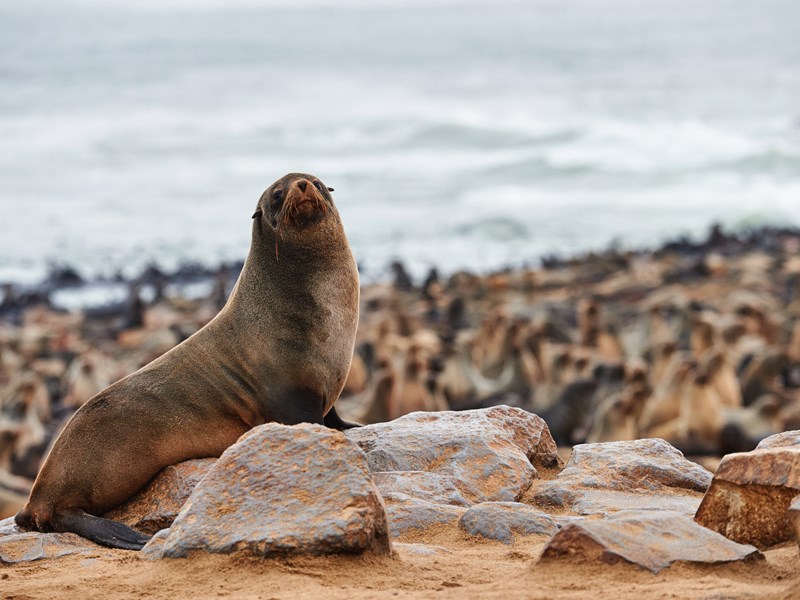Citizen science: The Seal Spotter Project
06 August 2024

When it comes to citizen science, Victoria has a range of ways people of all ages can become involved, and the Seal Spotter project, based in Phillip Island, is just one way Victorian's are contributing to science.
The Seal Spotter project calls on people to analyse aerial photos of the Australian fur seal population at Seal Rocks. This allows researchers from Phillip Island Nature Parks to monitor the number of seals and how many become entangled in rubbish. This is no small task, with Seal Rocks being home to an estimated 20,000 seals.
In 2021, as part of the Parliament Presents STEM and Society series, Dr Rebecca McIntosh and Ross Holmberg from Phillip Island Nature Parks talked about their experience with the project.
The Seal Spotter Project can be used as a stand alone case study where students can explore the purpose and impact of such projects, or can be used in conjunction with our Action and Influence teacher guide, which explores different frameworks for students to identify how each action works to bring about change.
The Seal Spotter Project
We have curated clips from the Parliament Presents interview, which you can use to guide discussions with your students.
The full video can be viewed on the Parliament of Victoria YouTube Channel (Please be aware that the video contains images of seals in distress, for example seals entangled in fishing nets).
Before watching the videos, you may like students to consider the following questions:
- Why might people get involved in citizen science projects like the Seal Spotters?
- What are some of the benefits to people participating in citizen science projects?
- What are some of the benefits for the scientists involved in projects like the Seal Spotters?
Videos
What is the Seal Spotter project?
Why study seals and what can we learn from them?
How can we help the seal population?
Discussion questions
- What kind of data do the citizen scientists collect and how might this data be used in the future?
- How might involvement in the Seal Spotter project influence people’s attitudes towards wildlife and science?
- What long term impacts and influence might citizen science projects have?
- How might data collected by citizen scientists be used to inform new laws or changes to laws?
- If people don’t participate in civic science projects, what other actions can people take to protect wildlife, like seals?
Analysing citizen science projects
- Where does citizen science fit within the “participation, advocacy and activism” diagram? Explain your response.
- Based on the data that the citizenship science projects collect, what further actions might you recommend the scientists take? Consider:
- The direction of action (bottom-up vs top down)
- The amount of change over time (incremental versus radical)
- The scale of impact (local to global)
Additional Activities
Consequences Table
Data collected by citizen scientists can be used to generate scientific evidence that influences change, for example, project findings from citizen science projects may be used to inform public policy or laws. For the citizen scientist, it gives them an opportunity to share views and have more say over how science is done, sometimes even the questions being investigated.
A consequences table is a useful tool for exploring the possible effects of an action. For each of the hypothetical examples, encourage students to predict an outcome and any flow-on effects. Students can also create their own hypothetical examples, or research actions that have been taken as part of a citizen science project.
| Action | Possible Oucome/s | |
| Citizen scientists collect data which shows the number of a rare plant found along a popular walking route are declining due to foot traffic. |
⇒ |
|
Citizen science project inquiry
A range of citizen science projects are available in Victoria. Students may choose one to explore and investigate the possible consequences participating in that citizen science project may lead to using the guiding questions below.
There are a variety of ways to approach exploring citizen science projects, including the use of inquiry question/s or thinking routines to analyse both the process and outcomes of a project. Some examples of these approaches, as well as some citizen science projects in Victoria, are included below.
Inquiry questions
These questions can be used as a starting point for a large inquiry project or for smaller responses, where students consider the impact (including potentialy benefits and limitations) of citizen science projects.
- How might citizen science make meaningful contributions to the scientific community?
- How might a scientists job change with or without citizen scientists?
- What might change if citizen science projects didn't exist?
Other questions to consider include:
- What are the consequences for the citizen scientist?
- What are the consequences for the professional scientist?
- Who benefits most?
- How will the data generated from the project be used and can it influence change?
Thinking routines
Thinking routines, such as these from Harvard Project Zero, can provide students a framework for exploring different apects of citizen science projects. There are a lot of different routines to choose from, but here are a few you might like to start with:
- Circle of Viewpoints
- Claim, Support, Question
- Projecting Across Time
- Projecting Across Distance
- Parts, People, Interactions
Example citizen science projects
Students could choose from one of the projects below or find their own: